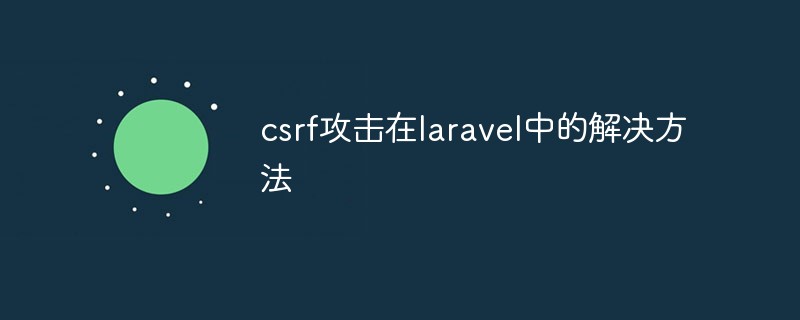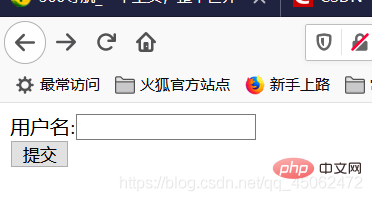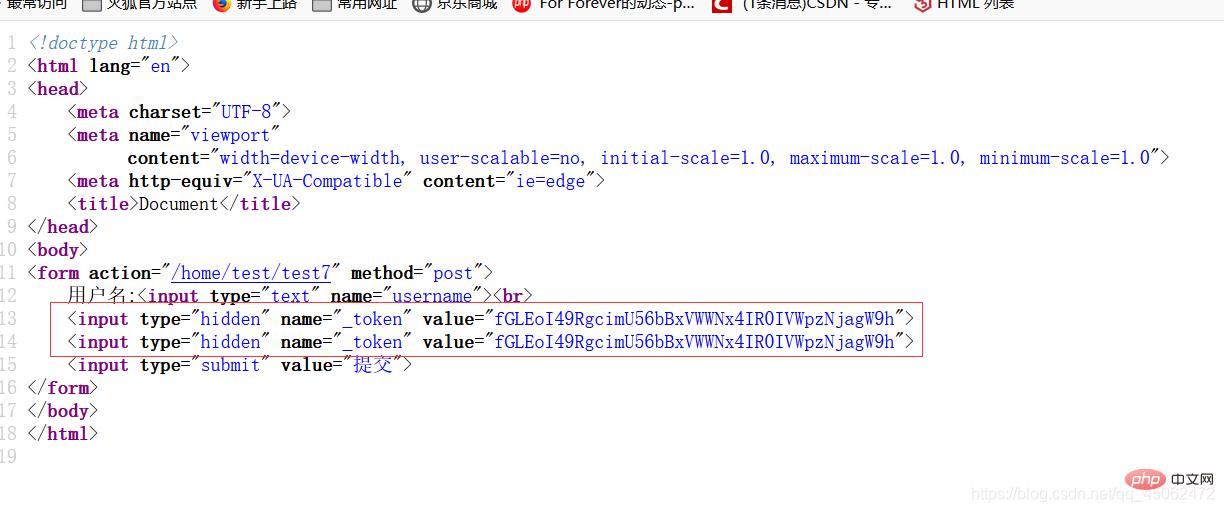Solution to csrf attack in laravel
Solution: 1. Use Laravel to automatically generate a "CSRF Token" for each user Session. This Token can be used to verify whether the logged in user and the person who initiated the request are the same person. If not, the request will fail; 2 , provides a global helper function "csrf_token" to obtain the Token value, just add the token code in the view submission form, the syntax is "<...value php="" echo="">".

The operating environment of this article: Windows 10 system, Laravel version 9, Dell G3 computer.
Solution to csrf attacks in laravel
CSRF is the English abbreviation of Cross-site request forgery;
It is very difficult to avoid CSRF attacks in the Laravel framework Simple:
1. Laravel automatically generates a CSRF Token for each user Session. This Token can be used to verify whether the logged in user and the requester are the same person. If not, the request will fail. (The principle is the same as the verification code.)
2. Laravel provides a global helper function csrf_token to obtain the Token value, so you only need to add the following HTML code to the view submission form to include it in the request. Token:
<input type="hidden" name="_token" value="<?php echo csrf_token(); ?>">
How to avoid CSRF attacks in Laravel
Case: Implement csrf mechanism verification through cases
1. Create two routes, one for display Form (get), and handle requests (post)
Route::get('test6','Home\TestController@test6');Route::post('test7','Home\TestController@test7');
2. Create the required method
public function test6(){
return view('home.test.test6');
}
public function test7()
{
return "请求提交成功";
}3. Create the required simple form

4. Submission effect (error page)

Conclusion: Through the case just now, it shows that the csrf verification mechanism in laravel is enabled by default.
5. Solve the error problem (how to pass csrf verification)
Solution: bring the token value required for csrf, and pass it to the subsequent method with the request
<form action="/home/test/test7" method="post">
用户名:<input type="text" name="username"><br>
<input type="hidden" name="_token" value="{{csrf_token()}}">
{{csrf_field()}}
<input type="submit" value="提交"></form>Simplification of the csrf_token method : {{csrf_field()}}
Specific expression:

The difference between the two:
Csrf_token only outputs token Value
Csrf_field outputs an entire input hidden field
How to choose when using it later: In most cases, you can choose according to the situation. However, there is a situation where the developer does not have the right to choose and must use csrf_token. In this case, the asynchronous form submission method is used.
Exclude exception routing from CSRF verification
Not all requests need to avoid CSRF attacks, such as requests to third-party APIs to obtain data.
You can set exceptions by adding the request URLs to be excluded to the $except property array in the VerifyCsrfToken (app/Http/Middleware/VerifyCsrfToken.php) middleware:
Set exceptions by writing configuration:
Single Route exclusion writing method
'home.test.test6',
Multiple elements are separated by "," and follow the array writing method.
'home.test.test6','home.test.test7'
If you need to exclude all routes and use csrf, you can write:
'*'
[Related recommendations: laravel video tutorial]
The above is the detailed content of Solution to csrf attack in laravel. For more information, please follow other related articles on the PHP Chinese website!

Hot AI Tools

Undresser.AI Undress
AI-powered app for creating realistic nude photos

AI Clothes Remover
Online AI tool for removing clothes from photos.

Undress AI Tool
Undress images for free

Clothoff.io
AI clothes remover

AI Hentai Generator
Generate AI Hentai for free.

Hot Article

Hot Tools

Notepad++7.3.1
Easy-to-use and free code editor

SublimeText3 Chinese version
Chinese version, very easy to use

Zend Studio 13.0.1
Powerful PHP integrated development environment

Dreamweaver CS6
Visual web development tools

SublimeText3 Mac version
God-level code editing software (SublimeText3)

Hot Topics
 1381
1381
 52
52
 Comparison of the latest versions of Laravel and CodeIgniter
Jun 05, 2024 pm 05:29 PM
Comparison of the latest versions of Laravel and CodeIgniter
Jun 05, 2024 pm 05:29 PM
The latest versions of Laravel 9 and CodeIgniter 4 provide updated features and improvements. Laravel9 adopts MVC architecture and provides functions such as database migration, authentication and template engine. CodeIgniter4 uses HMVC architecture to provide routing, ORM and caching. In terms of performance, Laravel9's service provider-based design pattern and CodeIgniter4's lightweight framework give it excellent performance. In practical applications, Laravel9 is suitable for complex projects that require flexibility and powerful functions, while CodeIgniter4 is suitable for rapid development and small applications.
 How do the data processing capabilities in Laravel and CodeIgniter compare?
Jun 01, 2024 pm 01:34 PM
How do the data processing capabilities in Laravel and CodeIgniter compare?
Jun 01, 2024 pm 01:34 PM
Compare the data processing capabilities of Laravel and CodeIgniter: ORM: Laravel uses EloquentORM, which provides class-object relational mapping, while CodeIgniter uses ActiveRecord to represent the database model as a subclass of PHP classes. Query builder: Laravel has a flexible chained query API, while CodeIgniter’s query builder is simpler and array-based. Data validation: Laravel provides a Validator class that supports custom validation rules, while CodeIgniter has less built-in validation functions and requires manual coding of custom rules. Practical case: User registration example shows Lar
 Which one is more beginner-friendly, Laravel or CodeIgniter?
Jun 05, 2024 pm 07:50 PM
Which one is more beginner-friendly, Laravel or CodeIgniter?
Jun 05, 2024 pm 07:50 PM
For beginners, CodeIgniter has a gentler learning curve and fewer features, but covers basic needs. Laravel offers a wider feature set but has a slightly steeper learning curve. In terms of performance, both Laravel and CodeIgniter perform well. Laravel has more extensive documentation and active community support, while CodeIgniter is simpler, lightweight, and has strong security features. In the practical case of building a blogging application, Laravel's EloquentORM simplifies data manipulation, while CodeIgniter requires more manual configuration.
 Laravel vs CodeIgniter: Which framework is better for large projects?
Jun 04, 2024 am 09:09 AM
Laravel vs CodeIgniter: Which framework is better for large projects?
Jun 04, 2024 am 09:09 AM
When choosing a framework for large projects, Laravel and CodeIgniter each have their own advantages. Laravel is designed for enterprise-level applications, offering modular design, dependency injection, and a powerful feature set. CodeIgniter is a lightweight framework more suitable for small to medium-sized projects, emphasizing speed and ease of use. For large projects with complex requirements and a large number of users, Laravel's power and scalability are more suitable. For simple projects or situations with limited resources, CodeIgniter's lightweight and rapid development capabilities are more ideal.
 Laravel - Artisan Commands
Aug 27, 2024 am 10:51 AM
Laravel - Artisan Commands
Aug 27, 2024 am 10:51 AM
Laravel - Artisan Commands - Laravel 5.7 comes with new way of treating and testing new commands. It includes a new feature of testing artisan commands and the demonstration is mentioned below ?
 Laravel vs CodeIgniter: Which framework is better for small projects?
Jun 04, 2024 pm 05:29 PM
Laravel vs CodeIgniter: Which framework is better for small projects?
Jun 04, 2024 pm 05:29 PM
For small projects, Laravel is suitable for larger projects that require strong functionality and security. CodeIgniter is suitable for very small projects that require lightweight and ease of use.
 Which is the better template engine, Laravel or CodeIgniter?
Jun 03, 2024 am 11:30 AM
Which is the better template engine, Laravel or CodeIgniter?
Jun 03, 2024 am 11:30 AM
Comparing Laravel's Blade and CodeIgniter's Twig template engine, choose based on project needs and personal preferences: Blade is based on MVC syntax, which encourages good code organization and template inheritance. Twig is a third-party library that provides flexible syntax, powerful filters, extended support, and security sandboxing.
 Laravel - Pagination Customizations
Aug 27, 2024 am 10:51 AM
Laravel - Pagination Customizations
Aug 27, 2024 am 10:51 AM
Laravel - Pagination Customizations - Laravel includes a feature of pagination which helps a user or a developer to include a pagination feature. Laravel paginator is integrated with the query builder and Eloquent ORM. The paginate method automatical




